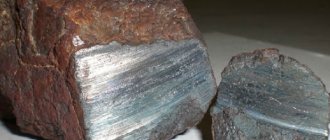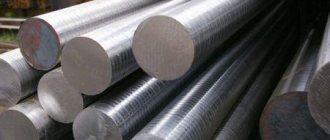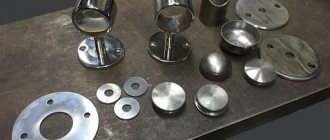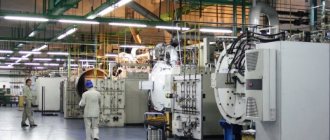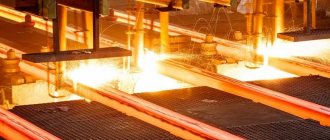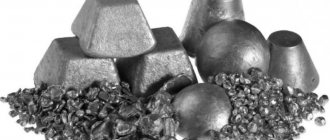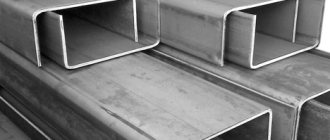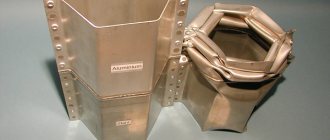Features of the material
There is a big difference between steel and cast iron. To identify it, you need to familiarize yourself with the definitions and characteristics of metals.
Cast iron
Cast iron is made up of iron and carbon. In this case, the amount of the second component should be more than 2%. Raw materials are doped with various additives. These include silicon, phosphorus, manganese and other substances.
Depending on the crystal lattice formed, there are the following types of cast iron:
- White - the name is due to the shade of the fractured material. It is associated with the presence of cementite in the composition. In addition to hardness, the material is brittle. By annealing it is used to produce malleable cast iron.
- Gray - the shade of the raw material is due to the high graphite content. The material is distinguished by its plasticity and ease of processing. The composition contains sulfur, phosphorus, magnesium and silicon.
- Malleable – Prolonged annealing of white cast iron results in the formation of graphite. This substance makes the metal very ductile, viscous and hard. In addition, it gives it good impact resistance.
- High strength - the formation of spherical graphite during crystallization provides the substance with a high degree of strength.
- Ultimate – subject to further processing. It cannot be used as an independent unit.
The melting point of this metal is at the level of 1160-1250 degrees. The specific value is determined by the carbon content. The more substance in the composition, the lower its temperature and the greater the fluidity when heated. This dependence is associated with the fragility of the substance.
Steel
This material contains 45% iron and 2% carbon. Depending on the grade, steel may contain additional substances. These include chromium, nickel, manganese, silicon and others. Depending on the alloying components, the properties of the material also change.
Carbon provides the material with hardness and strength properties. Thanks to the presence of this substance, the material is durable and flexible. It is quite easy to handle.
Depending on the content of alloying substances, steel can have the following varieties:
- low alloy;
- medium alloyed;
- highly alloyed.
Depending on the carbon content, there are the following types of steel:
- low carbon;
- medium carbon;
- high carbon.
The melting point of all brands is 1450-1520 degrees. Density parameters are at the level of 7700-7900 kilograms per 1 cubic meter.
Steel has a wide range of applications. It is used in industry in the manufacture of various types of metal structures, machine elements, pipelines and other products. In everyday life, people use interior items, dishes, and furniture made of steel.
Iron
Pure iron can only be found in laboratory conditions. In addition, it cannot be used for mass production of spare parts, plumbing fixtures or household items. Unlike cast iron, iron has a light silver tint, softness and ductility. In addition, it is highly susceptible to corrosion.
Expert opinion
Karnaukh Ekaterina Vladimirovna
Graduated from the National University of Shipbuilding, majoring in Enterprise Economics
It is important not to confuse iron with steel, which is its derivative. These concepts cannot be considered interchangeable. Steel is an alloy of iron with a small amount of additives. Sulfur, phosphorus, silicon, manganese, and carbon are used as additional components. The resulting iron-carbon alloy is elastic. It is malleable and deformable.
Characteristics of types of carbon metal
The iron-carbon diagram shows what cast iron is made of. In addition to iron, carbon is present in the form of graphite and cementite.
The composition of the cast iron alloy has varieties:
- White. The carbon present here is in a chemically bound state. The metal is strong, but brittle and therefore difficult to machine. In industry it is used in the form of castings. The properties of the material allow it to be processed with an abrasive wheel. The welding process causes difficulty, since there is a possibility of cracks due to the heterogeneity of the structure. Found application in areas related to dry friction. Has increased heat resistance and wear resistance.
- Half-hearted. It has increased fragility, so it is not widely used.
- Grey. GOST 1412–85 indicates what percentage of impurities this metal contains: 3.5% carbon, 0.8% manganese, 0.3% phosphorus, 0.12% sulfur and up to 2.5% silicon. The carbon present in the platelet form creates low impact strength. The characteristics of the type indicate that the material works better in compression than in tension. When heated sufficiently, it has good weldability.
- Malleable. A ferrite base of this type provides it with high ductility. When broken, it has a black, velvety color. It is obtained from white, which languishes for a long time at a temperature of 800-950 degrees.
- Highly durable. The difference from other types is the presence of spherical graphite. It is obtained from gray after adding magnesium to it.
How are they different?
Carbon components give the molecular structure strength and hardness. At the same time, the fragility of products increases under heating, shock and vibration loads. Plastic material easily withstands these types of impacts.
The main difference between cast iron and steel is the carbon content. Alloys can be alloyed with the same metals. However, the results are different. This is due to differences in the carbide lattices.
Composition and microstructure
When making steel, iron, carbon and impurities are combined. Moreover, the amount of carbon in the composition should be no more than 2%, and the iron content should be no less than 45%. The remaining percentage comes from alloying substances - they are used to bind the mixture. Such components include chromium, nickel, and molybdenum.
Due to the presence of carbon, iron becomes more durable and acquires the required hardness. Without it, the mass would turn out viscous and plastic.
Cast iron is also made from iron and carbon. However, the amount of the second component in the mixture exceeds 2%. In addition, permanent impurities are also introduced into the cast iron. These include phosphorus, sulfur, silicon, manganese, as well as alloying substances.
Production
In production conditions, the type of metal can be determined in the following ways:
- By fracture - this visual method is used for parts that are scrapped or used as blanks. A matte dark gray color is noticeable on scrap cast iron. In this case, the cracks that form have a pronounced structure. Steel products are lighter and have a glossy surface.
- Drilling – steel shavings have a twisted shape. It is longer than the drill and bends easily. Cast iron shavings crumble even with slight impact.
- Grinding - as a result of the passage of a grinding machine, the steel surface is covered with a large number of yellow and white sparks. Cast iron has fewer sparks. In addition, they are shorter and have a reddish tint.
Characteristics
It is possible to identify differences between workpieces that can be processed by visual signs. On scrapped cast iron products, a dark gray tint with a matte surface is visible. At the same time, the steel has a lighter color and glossy texture.
The appearance of the metal is influenced by the amount of carbon components. They can be distinguished by the type of cracks. High-carbon steel surfaces are characterized by defects in the form of splitting. If the product is made of a low-carbon alloy, the cracks resemble a plastic break.
Differences between metals also lie in technical characteristics. Steel has the following properties:
- density – 7700-7900 kilograms per 1 cubic meter;
- melting point – 1450-1520 degrees;
- strength, wear resistance, hardness;
- resistance to deformation;
- high ductility - this helps to process metal in different ways;
- the possibility of improving the quality of the material through hardening;
- the possibility of improving the properties of the alloy by introducing alloying additives.
Cast iron is also an alloy of iron and carbon. However, the content of the second component is higher. The same applies to additional components. Therefore, cast iron is considered a more fragile material - it breaks easily.
The melting point of cast iron depends on the carbon content. As the volume of this component increases, the temperature decreases. In addition, there is an increase in fluidity when heated. This does not have the best effect on the performance properties - fragility, ductility, ease of processing. The melting point of cast iron is 1160-1250 degrees.
Strength
Steel is stronger compared to cast iron. It is stronger due to its structure. The increased carbon content in cast iron makes it more brittle and less ductile.
Carbon content
Steel differs from cast iron in carbon content. The amount of this component in the metal does not exceed 2%. Cast iron typically has a carbon volume greater than 2.14% but less than 4.5%.
Scope of application
Cast iron is considered a casting material. It is used to make simple dishes, machine bodies, and massive pipes. Large objects of simple configuration are also made from metal. Parts of different sizes and complexity are made from steel, since forging, drawing, stamping, and rolling are used for this. It is also permissible to use other processing methods for this metal.
Expert opinion
Karnaukh Ekaterina Vladimirovna
Graduated from the National University of Shipbuilding, majoring in Enterprise Economics
If the question arises what the reinforcement is made of, there is no doubt - it is steel. If you are interested in the composition of a large cauldron, you can say with confidence that it is made of cast iron. In this case, the engine housing or crankshaft can be made of any metal. Therefore, in this case, you need to resort to recognition methods.
How to distinguish cast iron from steel?
To distinguish these metals from each other, you can use the following methods:
- Drilling. To do this, you will need to take a nozzle with a small diameter and, having selected a flat area on the workpiece, drill a small hole. If, when processing a material, thin chips are formed, which are formed into a twisted strip longer than the drill used, have tarnish colors along the entire length and bend well enough, the workpiece is made of steel. The cast iron alloy is less ductile, it practically does not form a loach, and the shavings crumble from the slightest mechanical impact: they are easy to grind to a powder state, since the material is more fragile;
- Grinding. For this, an angle grinder is used; for processing, select an area that is not affected by frictional forces, contact with other metal surfaces or parts, otherwise, after grinding, the product may be unsuitable for further use. During the processing process, it is necessary to monitor the color of the spark and its shape. If the alloy is cast iron, the spark will be short, the sprocket will have a reddish tone, and if the part is made of steel, more sparks will fly out, they will have an increased size and an oblong shape. The sparks themselves are yellow or white. The exception is steel alloys with a high carbon content, which produce a short, purple spark with a shortened track and a small sprocket.
Mechanical impact methods can be used in everyday conditions, when you need to determine whether the material in front of you is cast iron or steel, without the use of special equipment. The laboratory can use modern technology, with the help of which spectral or microscopic analysis of the properties of metals is carried out. These methods provide highly accurate results, but are used primarily for industrial purposes, in production and in the scientific and technical industry due to the complexity and high cost of the equipment.
Source
Pros and cons of each metal
Alloys have certain advantages and disadvantages. The advantages of steel include the following:
- high margin of strength and hardness;
- a large number of properties - this is due to different options for alloying impurities;
- optimal ratio of elasticity and viscosity - the material perfectly withstands static, dynamic and shock loads;
- ease of processing;
- high margin of safety - due to this, the material has a long service life;
- simplicity and affordable cost of casting.
However, the material also has a number of disadvantages:
- poor corrosion resistance - this applies to pure types of steel that do not contain alloying components;
- high electromechanical corrosion - this is due to the property of storing electrical energy;
- heavy weight of steel structures;
- high risk of defects - this is due to the multi-stage manufacturing process.
Cast iron has the following advantages:
- high level of strength - some brands are comparable in this parameter to steel;
- uniform heat distribution and the possibility of long-term preservation;
- safe composition - this allows the use of cast iron for making cookware;
- resistance to acids and alkalis;
- high degree of hygiene;
- durability.
However, metal also has some disadvantages:
- risk of corrosion processes due to prolonged exposure to water;
- lack of ductility of gray cast iron;
- increased fragility of white material.
Alloy steels
The table for decoding steels by composition is presented below.
| Designation | Chem. element | Name | Designation | Chem. element | Name |
| X | Cr | Chromium | A | N | Nitrogen |
| WITH | Si | Silicon | N | Ni | Nickel |
| T | Ti | Titanium | TO | Co | Cobalt |
| D | Cu | Copper | M | Mo | Molybdenum |
| IN | Wo | Tungsten | B | Nb | Niobium |
| G | Mn | Manganese | E | Se | Selenium |
| F | W | Vanadium | C | Zr | Zirconium |
| R | B | Bor | YU | Al | Aluminum |
If the name contains the letter “H”, then the alloying elements include rare earth elements - niobium, lanthanum, cerium.
Cerium (Ce) – affects strength characteristics and ductility.
Lanthanum (La) and neodymium (Ne) - reduce the sulfur content and reduce the porosity of the metal, leading to a decrease in grain size.
Quick comparison table
The main differences between metals are briefly presented in the table:
| Steel | Cast iron |
| Has high strength and hardness. | It is considered a more fragile and less ductile material. |
| Has a higher melting point. | Differs in lower melting temperatures. |
| Contains less than 2% carbon. | Includes more than 2% carbon. |
| It is less porous and has greater thermal conductivity. | Contains more pores and is characterized by lower thermal conductivity. |
| It has a light shade and shiny surface. | It is distinguished by its dark color and matte surface. |
| Has a higher cost. | It costs less. |
Decoding steels: examples
For an example of decoding, consider the common steel grade 12Х18Н10Т.
The number “12” at the beginning of the brand name is an indicator of the carbon content in this steel; it does not exceed 0.12%. Next comes the designation “X18” - therefore, the steel contains the element chromium in an amount of 18%. The abbreviation “H10” indicates the presence of nickel in a volume of 10%. The letter “T” indicates the presence of titanium, the absence of a digital expression means that it is less than 1.5%. Obviously, a qualified decoding of steel by composition immediately gives an idea of its quality characteristics.
If we compare the designations of alloy and carbon steels, this becomes a noticeable difference, indicating the special properties of the metal due to specially introduced alloying additives. Decoding steels and alloys indicates their chemical composition. The main alloying additives are:
- nickel (Ni) – reduces chemical reactivity and improves the hardenability of the metal;
- chromium (Cr) – increases the tensile strength and yield strength of alloys;
- niobium (Nb) – increases acid resistance and corrosion resistance of welded joints;
- cobalt (Co) – increases heat resistance and impact strength.
Melting temperatures of steel
Under certain conditions, solids melt, that is, they turn into a liquid state. Each substance does this at a certain temperature.
- Melting is the process of transition of a substance from a solid to a liquid state.
- Melting point is the temperature at which a crystalline solid melts into a liquid state. Denoted by t.
Physicists use a specific table of melting and crystallization, which is given below:
| Substance | t,°C | Substance | t,°C | Substance | t,°C |
| Aluminum | 660 | Copper | 1087 | Alcohol | — 115 |
| Voden | — 256 | Naphthalene | 80 | Cast iron | 1200 |
| Tungsten | 3387 | Tin | 232 | Steel | 1400 |
| Iron | 1535 | Paraffin | 55 | Titanium | 1660 |
| Gold | 1065 | Mercury | — 39 | Zinc | 420 |
Based on the table, we can safely say that the melting point of steel is 1400 °C.
Positive aspects of doping
The peculiarities of the properties are most clearly manifested after heat treatment; therefore, all parts made of such steel are processed before use.
- Steels and alloys improved by alloying have higher mechanical properties compared to structural ones.
- Alloying additives help stabilize austenite, improving the hardenability of steels.
- Due to the reduced degree of austenite decomposition, the formation of quenching cracks and warping of parts is reduced.
- Impact strength increases, which leads to a decrease in cold brittleness, and parts made of alloy steels have higher durability.
History [edit | edit code]
The technology of cast iron was mastered in China, from where this term (through Tatar-Mongol mediation) came to Russia [1]. In the 10th century, cast iron coins appeared in China, but bronze coins remained in widespread use until the 19th century [2]. In the 11th century, the cast iron spire of the Lingxiao Pagoda was erected. The finds of cast iron boilers of the Golden Horde (Tula region) date back to the 14th century [3], but in the territory of Mongolia (Karakorum) the Mongols knew how to make cast iron boilers back in the 13th century [4].
In 1339 (during the Hundred Years' War), cast iron cannons were already used along with bronze ones in the defense of the French city of Cambrai. In 1403, a cast iron bell was cast in China (Beijing) [5]. Since 1411, the British began to arm their ships with cast iron cannons [6]. In the same 15th century, cast iron cores began to be cast in Flanders, which replaced stone ones [7]. In the 16th century in Russia (under Ivan the Terrible), guns began to be made from cast iron [8]. Due to the lack of cast iron such properties as malleability, its widespread production became possible thanks to the introduction of blast furnace technology. Cast iron cannons appeared among the Manchus only in 1631 [9], and in China they were known since the Ming Dynasty [10], which lost power in 1644.
In 1701, the Kamensky iron foundry in the Urals (Russia) produced the first batch of cast iron (262 kg). In the Urals, iron casting turned into a folk craft (Kasli casting). In the 18th century, the first cast iron bridge appeared in England (in Russia, a cast iron bridge appeared only at the beginning of the 19th century). This was made possible thanks to Wilkinson's technology. In the same century, rails began to be made from cast iron [11] (Cast iron wheel line). In addition to industrial use, cast iron continued to be used in everyday life. In the 18th century, cast iron pots appeared and were widely used in Russian stoves [12].
By the end of the 18th century, Russia took first place in the production of cast iron and produced 9,908 thousand pounds of cast iron, while England - 9,516 thousand pounds, followed by France, Sweden, and the USA. [13]
In 1806, Great Britain smelted 250 thousand tons of cast iron, ranking first in the world in its production, and by the middle of the 19th century, half of the world's cast iron production was concentrated in Great Britain. However, in 1890, the United States took first place in cast iron production [14]. The technology of the Bessmer process (1856) and the open-hearth furnace (1864) made it possible for the first time to produce steel from cast iron. In the 19th century, cast iron was widely used for the manufacture of Victorian fireplaces [15], as well as decorative elements (for example, the cast iron grate of the monument to Alexander II, 1890). Thanks to the production of small sculptures and openwork items made of cast iron, the Kusinsky and Kasli factories became widely known. The development of molding methods for casting complex artistic castings at a plant in the village of Kasli led to the creation of a method for producing core molds, which is still used today, especially in machine tool building. [16] Also in the 19th century, London's 12-inch water and sewer pipes were made from cast iron [17] . However, with the advent of rifled weapons (Armstrong's Gun, 1854), steel again began to replace cast iron.
| Cast iron |
| Phases of iron-carbon alloys |
| Structures of iron-carbon alloys |
Negative sides
Along with the positive aspects, steel alloying also has a number of characteristic disadvantages. These include the following:
- In products made from alloy steels, reversible temper brittleness of the second type is observed.
- High-alloy class alloys include retained austenite, which reduces hardness and fatigue resistance.
- Tendency to form dendritic segregations, which leads to the appearance of stitch structures after rolling or forging. To eliminate the effect, diffusion tempering is used.
- Such steels are prone to flake formation.
Etymology [edit | edit code]
In Russian, the word cast iron is of Turkic origin, while in Turkic languages the term is probably from kit. trad. 鑄, pinyin: zhù
, pal.:
zhu
, literally: “to pour;
cast (metal)" and whale. trad. 工, pinyin: gōng
, pal.:
gong
, literally: “deed” [1].
This is due to the fact that cast iron was a low melting iron alloy. In Finnish, cast iron is denoted by the word Valurauta
, which has two roots and is translated as cast iron (
rauta
).
Ore mining
ore and fuel first But even if we have sufficient quantities of iron ore and coal, (more details: Natural Energy Resources) we cannot yet begin to manufacture steel. Both ore and coal must be prepared in a special way. Process ore and make coke from coal.
Ore beneficiation
Ore travels a long and difficult path before it turns into steel. And the first stage on this path is the enrichment of ore at a processing plant. First, the ore is crushed using machines called crushers. The first, the most powerful, splits large blocks into pieces. Then the second turns these pieces into crushed stone and so on.
Until the ore turns into cereal. But this is not yet complete enrichment. Next, the ore is sent to a mill and turned into powder. And only now begins what metallurgists call enrichment - the separation of ore from the accompanying rock with which it lay in the ground. It happens like this. The powder is mixed with water and passed between magnets.
Magnets and select particles of magnetic iron ore from the turbid flow. And what is not needed - it is no longer difficult to guess - is carried away by water. But even such selected ore is not yet suitable for further processing. The iron content in it has increased significantly. However, that's not all. The ore must again be turned from powder into pieces. To do this, the powder is mixed with coke, lime and heated strongly.
Coke
The main fuel for steel smelting is coal. But not in the form miners extract. Mined coal contains many impurities that can adversely affect the future metal. And therefore they need to be removed. Coal, like ore, is first ground into a fine powder. Then this powder is heated in a special chamber without access to air.
Coal releases gas and tar. Other unnecessary impurities also leave with them. And the coal powder itself is sintered into a dense porous mass. The blazing hot mass is pushed out of the chamber onto a metal platform and cooled with water. Due to sudden cooling, the mass falls into pieces. These pieces are coke . Now both the ore and fuel are prepared.
You can start melting. But we are not yet ready to melt steel. Before iron ore turns into steel, it still has to become pig iron. This process takes place in a blast furnace. A blast furnace is a giant furnace. Even a ten-story building does not seem very big next to such a stove. This stove burns continuously for decades.
Metallurgists from time to time load ore, coke and lime into it - this is also necessary during smelting - and produce finished cast iron. What processes take place in a blast furnace, how is ore turned into cast iron? To understand this, we must return to iron ore.
